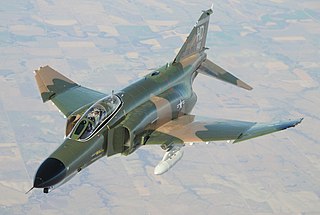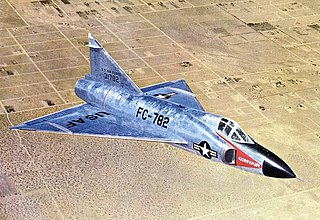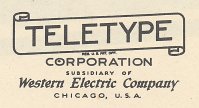
The McDonnell Douglas F-4 Phantom II is an American tandem two-seat, twin-engine, all-weather, long-range supersonic jet interceptor and fighter-bomber originally developed by McDonnell Aircraft for the United States Navy. Proving highly adaptable, it first entered service with the Navy in 1961 before it was adopted by the United States Marine Corps and the United States Air Force, and by the mid-1960s it had become a major part of their air arms. Phantom production ran from 1958 to 1981 with a total of 5,195 aircraft built, making it the most produced American supersonic military aircraft in history, and cementing its position as an iconic combat aircraft of the Cold War.

The Lockheed P-38 Lightning is an American single-seated, twin piston-engined fighter aircraft that was used during World War II. Developed for the United States Army Air Corps by the Lockheed Corporation, the P-38 incorporated a distinctive twin-boom design with a central nacelle containing the cockpit and armament. Allied propaganda claimed it had been nicknamed the fork-tailed devil by the Luftwaffe and "two planes, one pilot" by the Japanese. Along with its use as a general fighter, the P-38 was used in various aerial combat roles, including as a highly effective fighter-bomber, a night fighter, and a long-range escort fighter when equipped with drop tanks. The P-38 was also used as a bomber-pathfinder, guiding streams of medium and heavy bombers, or even other P-38s, equipped with bombs, to their targets. Used in the aerial reconnaissance role, the P-38 accounted for 90% of the aerial film captured over Europe.

Colonel Joseph William Kittinger II is a retired officer in the United States Air Force (USAF) and a Command Pilot. His initial operational assignment was in fighter aircraft, then he participated in Project Manhigh and Project Excelsior high-altitude balloon flight projects from 1956 to 1960. He set a world record for the highest skydive: 102,800 feet on August 16, 1960. He was also the first man to make a solo crossing of the Atlantic Ocean in a gas balloon, and the first man to fully witness the curvature of the Earth.

The Convair F-102 Delta Dagger was an American interceptor aircraft designed and manufactured by Convair. Built as part of the backbone of the United States Air Force's air defenses in the late 1950s, it entered service in 1956. Its main purpose was to intercept invading Soviet strategic bomber fleets during the Cold War. A total of 1,000 F-102s were built.

The Grumman F11F/F-11 Tiger is a supersonic, single-seat carrier-based United States Navy fighter aircraft in operation during the 1950s and 1960s. Originally designated the F11F Tiger in April 1955 under the pre-1962 Navy designation system, it was redesignated as F-11 Tiger under the 1962 United States Tri-Service aircraft designation system.
The Beechcraft L-23 Seminole was the United States Armed Forces designation for the Beechcraft Twin Bonanza and Queen Air aircraft in its inventory.

Conformal fuel tanks (CFTs) are additional fuel tanks fitted closely to the profile of an aircraft that extend the endurance of the aircraft.

The Boeing B-29 Superfortress was an aircraft produced in many experimental and production models.

Aphrodite and Anvil were the World War II code names of United States Army Air Forces and United States Navy operations to use Boeing B-17 Flying Fortress and Consolidated PB4Y bombers as precision-guided munitions against bunkers and other hardened/reinforced enemy facilities, such as "Crossbow" operations against German long range missiles.

The Grumman XP-50 was a land-based development of the shipboard XF5F-1 Skyrocket fighter, entered into a United States Army Air Corps (USAAC) contest for a twin-engine heavy interceptor aircraft. The USAAC placed an order for a prototype on 25 November 1939, designating it XP-50, but it lost the competition to the Lockheed XP-49.

The Fairchild C-26 "Metroliner" is the designation for the Fairchild Swearingen Metroliner series twin turboprop aircraft in the service of the United States military. It was not officially named by the US Armed Forces, but is unofficially known by the same name as its civilian counterpart. The C-26A is the military version of the Model SA227-AC Metro III; the C-26B is the military version of the Model SA227-BC Metro III and Model SA227-DC Metro 23; and UC-26C is the military designation for the Model SA227-AT Merlin IVC.

The Hall XPTBH was a prototype American twin-engined seaplane, submitted to the United States Navy by the Hall Aluminum Aircraft Corporation in response to a 1934 specification for new bomber and scout aircraft. Constructed in an innovative fashion that made extensive use of aluminum, the XPTBH proved successful in flight testing, but failed to win favor with the U.S. Navy. No production contract was awarded, and the single aircraft built served in experimental duties before its destruction in a hurricane during 1938.

The Teletype Corporation, a part of American Telephone and Telegraph Company's Western Electric manufacturing arm since 1930, came into being in 1928 when the Morkrum-Kleinschmidt Company changed its name to the name of its trademark equipment. Teletype Corporation, of Skokie, Illinois, was responsible for the research, development and manufacture of data and record communications equipment, but it is primarily remembered for the manufacture of electromechanical teleprinters.

Edgar O. "Ed" Schmued (Schmüd), German-American aircraft designer (1899–1985) was famed for his design of the iconic North American P-51 Mustang and, later, the F-86 Sabre while at North American Aviation. He later worked on other aircraft designs as an aviation consultant.

The Berliner-Joyce P-16 was a 1930s United States two-seat fighter aircraft produced by Berliner-Joyce Aircraft Corporation.

The Grumman XSBF, also known by the company designation G-14, was an American biplane scout bomber developed by Grumman Aircraft for the United States Navy during the 1930s. Derived from Grumman's successful "Fifi" fighter, the aircraft was developed at a time when the biplane was giving way to the monoplane. In competition against other aircraft it proved to possess inferior performance in its intended role, and did not enter production. The sole prototype went on to serve as a liaison aircraft, as well as being used in experiments by NACA, before being destroyed in a crash in 1939.

The 418th Test and Evaluation Squadron is an active United States Air Force unit assigned to the 53rd Test and Evaluation Group, and stationed at Davis-Monthan Air Force Base, Arizona, where it was activated on 1 October 2021.

The Chase XC-123A was an experimental transport aircraft developed by Chase Aircraft. The first jet-powered transport built for the United States Air Force, it was intended for use as a high-speed transport for high-priority cargo and personnel. The XC-123A was determined to have insufficient advantages over existing types in service, and did not go into production. The sole prototype was converted into the piston-powered Stroukoff YC-123D to evaluate boundary layer control systems.

Joseph T. Funk (c.1914–1981) was an American artist, printmaker, and educator. He was a sculptor, lithographer, and muralist. Funk worked as a master printmaker at Tamarind Lithography Workshop, Kanthos Press, and Joseph Press.

















